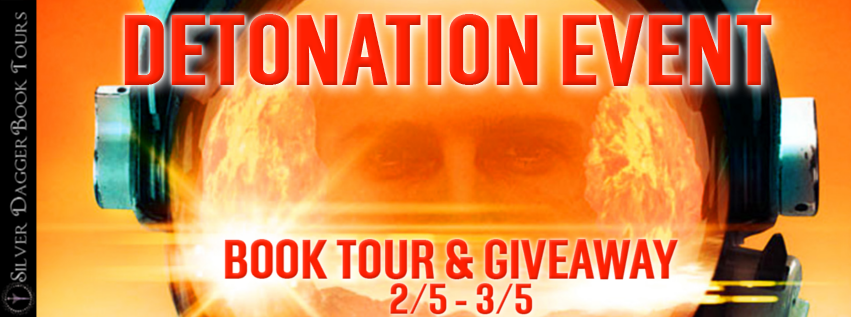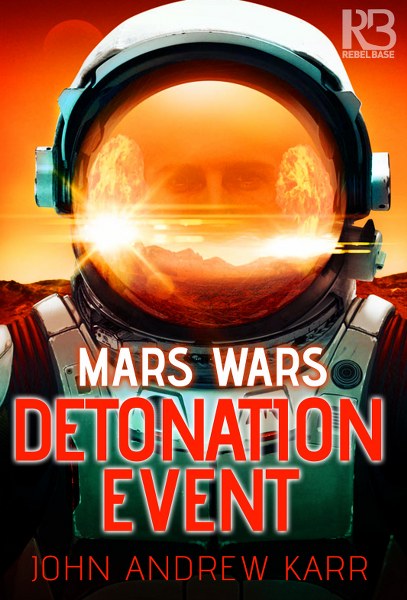Detonation Event by John Andrew Karr Book Tour and Giveaway :)
Detonation
Event
Mars
Wars #1
by
John Andrew Karr
Genre:
Science Fiction
Pub
Date: 2/5/19
For
decades the Space Consortium of America has searched for new ways to
harvest resources beyond an increasingly depleted Earth. The ultimate
plan is about to be ignited. So is the ultimate threat to humankind.
. .
Detonation
Event
Battle-hardened
Captain Ry Devans and his crew of the Mars Orbiting Station-1 are
part of a bold plan: resurrect the once-active molten cores of the
Red Planet with synchronized thermonuclear explosions, and terraform
the hell out of that iron-oxide rock for future generations. It’ll
change history. So will the strands of carbon-based Martian cells
that have hitched a ride on the ship.
Dr.
Karen Wagner knows the microbes’ resistance to virus is incredible.
It’s the unknowable that’s dicey. Her orders: blow them into
space. But orders can be undermined. Two vials have been stolen and
sent hurtling toward the biosphere. For Devans and Wagner, ferreting
out the saboteurs on board is only the beginning. Because there are
more of them back on Earth—an army of radical eco-terrorists
anxious to create a New World Order with a catastrophic gift from
Mars.
Now,
one-hundred-and-forty-million miles away from home, Devans is feeling
expendable, betrayed, a little adrift, and a lot wild-eyed. But space
madness could be his salvation—and Earth’s. He has a plan. And
he’ll have to be crazy to make it work.
“Detonation
Event starts with the unusual proposition that the
greatest difficulty in terraforming Mars will be not geophysics but
Earth politics--rising quickly to open warfare. Interesting and
intelligent.” --Dave Drake Author of Hammer's
Slammers
Prologue
2228 AD
The abyss and its twin gape at the
Martian sky as if aware of the pain to come. One in daylight, the other night, they
disrupt a global desert. The tunnels thrust to the very heart of the
planet, as if the God of War had twice speared his namesake and
wrought its demise. Mars was never a kind deity, and while he is no
longer capable of violence, his blood-colored world remains just as
hostile to life. Here the sun rises and sets without
mortality to mark the passage of time. The thin air constricts no
lungs. The cold bites neither flesh nor frond. Beds of ancient
waterways gather dust, indistinguishable from surrounding barrens.
Volcanoes stand as slowly withering ghosts. The underground
reservoirs that once supplied them with magma cooled to rock
millennia ago. Deeper still, the once-molten outer core endured the
same fate, entombing the mass of solid iron, nickel, and sulfur that
had been its heat source: the radioactive inner core. Both are cold
now, and there is no geologic activity throughout the entire planet. Mars orbits the sun—half again beyond
Earth’s orbit—as a rocky corpse. But perhaps not eternally doomed. The tunnels are the first phase of a
mission where the odds are seemingly light years long and without
historical precedent. Even if the mission is initially successful,
the duration is unknown. Something killed Mars before and can do it
again. But a chance at life has arrived where there was none. An
opportunity to restore the vibrancy of the planet’s youth, now only
hinted at with subterranean ice and mysterious impressions upon the
withered husk of the surface. In its first billion years, the red
planet may not have appeared red at all, but purple or even blue like
Earth, depending on the ratio of breathable air to iron oxide
particles spewed from volcanoes and lifted by wind from mountains and
deserts. Surface water existed in the form of streams and lakes and
perhaps even seas. Clouds of water vapor circled the globe. Lightning
flashed and thunder boomed. Rain fell on Mars. And it was no coincidence that the
planetary cores were active and “alive.” Radioactive heat loss and convective
currents of magma produced a magnetic field that bound the atmosphere
to the planet in a geologic dynamo, the like of which still functions
on Earth. What killed Mars? Perhaps its smaller size limited the
amount of radioactive supply, and it simply ran out of energy. Or
massive impact with an asteroid ejected the charged particles out to
space. Whatever the case, death arrived soon after the Martian inner
core went cold. Having lost its heat source, the molten outer core
turned to stone as if succumbing to the Hydra’s gaze. The dynamo
failed and its magnetism all but vanished. Gravity alone was too weak
to hold the atmosphere. Air and water molecules escaped into space.
Without a magnetic shield and atmosphere to deflect them, solar winds
and radiation further stripped the surface dry. Mars lost the means to support life
beyond a microbial level. Now temperature fluctuations spawn the
only weather events. Night and polar regions regularly plunge two
hundred degrees below zero Fahrenheit; cold enough to freeze its most
abundant gas—carbon dioxide—into dry ice, though at times the
equator at full sun can reach as high as sixty degrees. Far less
drastic temperature swings combine with the weak gravity in a near
vacuum to spawn frequent dust storms. The greater the temperature
difference, the larger the storm. Dust, prevalent everywhere, is lifted
rather than scoured from the surface. Storms of it can be monstrous,
at times engulfing the entire planet except for the gargantuan
Olympus Mons. Far more common are the dust devils that waltz through
a desolate Hell. Some of the rust-hued particles fall
into the open maws and down the tunnels. No twists or turns arrest their
journey. They gain no purchase along laser-bonded walls. Down they
drift like mineral snowfall, passing signal relays at every mile. The
dust falls for weeks toward the core. Recent inductees will never
reach bottom before Detonation Event. Electronic relays form a spiral pattern
and flash in sequence for two thousand miles, down and back again,
each briefly illuminating a section of tunnel along the way.
Constantly monitored by satellites positioned above, the relays are
members of a large supporting cast. The lead roles belong to the hydrogen
(thermonuclear) megabombs residing at the base of the each tunnel.
These are cutting-edge nuclear fusion explosives; the latest in the
class of Asteroid Busters. Ever silent, Mars awaits its chance at
resurrection.
John Andrew Karr writes of the strange and spectacular. He enjoys creating fantasy, paranormal, horror, and science fiction, having self-published novels in all these genres. He’s a North Carolina resident, IT worker, and all-around family guy.
Follow
the tour HERE
for exclusive content and a giveaway!








Comments
Post a Comment